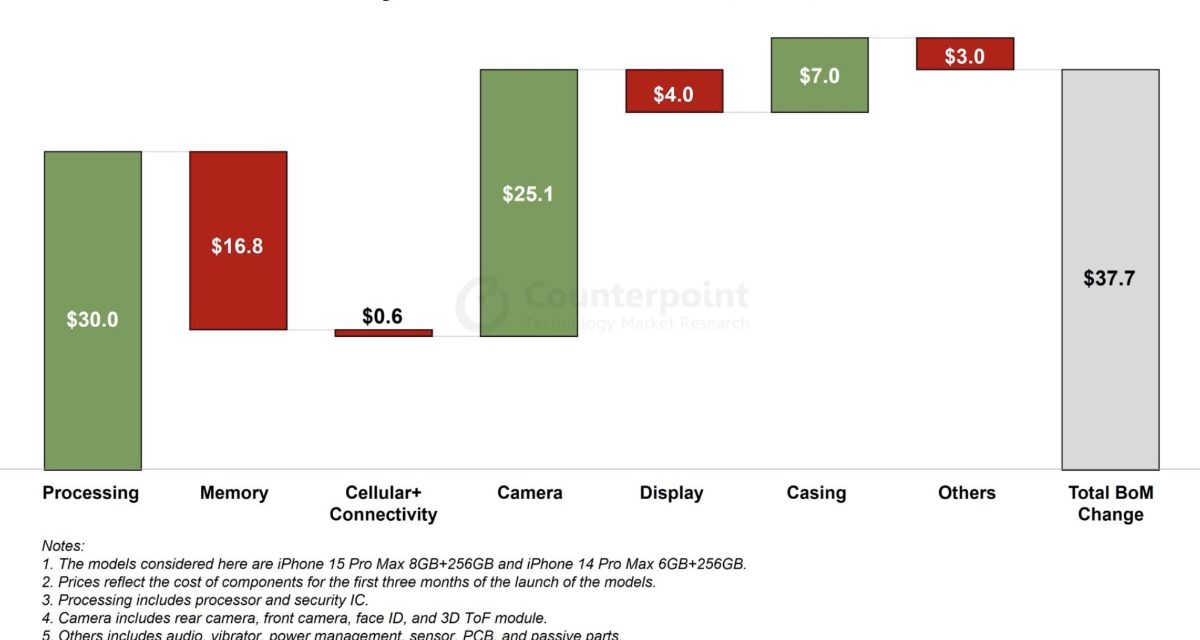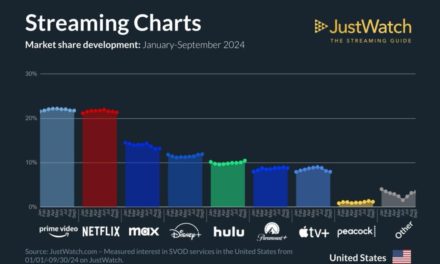Apple is charging US$100 more for its flagship iPhone this year, though it only costs an extra $37.7 to manufacture compared to the iPhone 14 Pro Max, according to Counterpoint Research.
With this increase of $100 in the starting retail price, the iPhone 15 Pro Max is expected to give Apple more profit as it has the highest gross margin in the iPhone 15 family, despite being the costliest model, notes the research group.
According to Counterpoint, these are the areas where the costs have risen
- First 3nm process-powered application processor: Apple’s new-generation mobile platform, the A17 Pro, uses TSMC’s most advanced 3nm fabrication technology and packs more than 19 billion transistors in a die, 18% more than that of the A16 Bionic. Thanks to the improved 6-core GPU architecture, the iPhone 15 Pro Max’s GPU performance is 20% faster. As a result, the A17 Pro can deliver vastly improved gaming performance with a breakthrough in enabling real-time 3D ray tracing. However, this SoC upgrade has resulted in a cost increase of around $30 compared with the A16.
- Apple’s first 5x telephoto camera: Another notable upgrade is the 5x telephoto camera featuring an equivalent 120mm focal length. This camera consists of a quadruple reflection prism that enables light rays to bounce four times, allowing users to capture sharper close-up shots from greater distances. Lante Optics is the primary supplier of this prism. Additionally, to match the new telephoto system, Apple has designed the 3D sensor-shift OIS in this camera which can make up to 10,000 micro-adjustments per second, enabling users to capture clearer, sharper photos and more stable videos. The development and assembly of the stabilization mechanism involved a collective effort from Cirrus Logic and LG Innotek. The overall cost of the camera system in the iPhone 15 Pro Max is 34% costlier than that of the iPhone 14 Pro Max.
- Titanium alloy casing: Apple has adopted a titanium alloy in the iPhone 15 Pro Max casing frame, which has reduced the device’s weight by around 20 g, making it the lightest Pro Max model ever. The cost of the new casing in the iPhone 15 Pro Max is 18% higher than that of the 14 Pro Max.
According to Counterpoint, these are the areas where the costs have fallen
- Memory: Apple has upgraded the iPhone 15 Pro Max’s DRAM to 8GB, which is 2GB higher than that of its predecessor. However, the global memory market was in a downtrend from Q4 2022 to Q3 2023, both DRAM and NAND flash prices have decreased by more than 30%. This has worked in favor of Apple, helping it offset some of the other cost increases as the contribution of memory chips dropped by 34% compared to the iPhone 14 Pro Max.
- Display: The display price is also in a downtrend. Apart from Samsung Display, LG Display has also started supplying iPhone LTPO displays. This has contributed to a reduction in display costs by 4% in the iPhone 15 Pro Max compared to that of the iPhone 14 Pro Max.
Here are the rising share of self-designed components (per Counterpoint)
Apple’s vertical ambitions are evident as its self-designed components, such as the processor, the upgraded UWB and power management ICs, are playing an increasingly significant role in the overall BoM cost of the iPhone 15 Pro Max, garnering Apple great economies of scale and control over the performance and end-user experience. Our estimates indicate that these self-designed components account for 25% of the total BoM cost of the iPhone 15 Pro Max, up from 22% in the iPhone 14 Pro Max last year.
Here are the key takeaways from Counterpoint’s study
- Apple has grown to a level where it has significant control over design, innovation, scalability, costs and profits of the entire iPhone and the other products in its portfolio.
- This is helping Apple with differentiation and is also allowing it to exercise not only significant selling power but also buying power through great vertical design expertise and sourcing of components.
- Also, having the most powerful smartphone SoC manufactured at the most advanced process node has allowed Apple to design an SoC with high-performance CPU, pro-class GPU and dedicated neural engines to build pervasive AI experiences, efficiently blending with its vertical software (OS) capability and (apps) ecosystem.
- Apple is, thus, raising the table stakes for competition with its flagship, which is set to be the most lucrative iPhone in terms of top line and bottom line.
Article provided with permission from AppleWorld.Today




